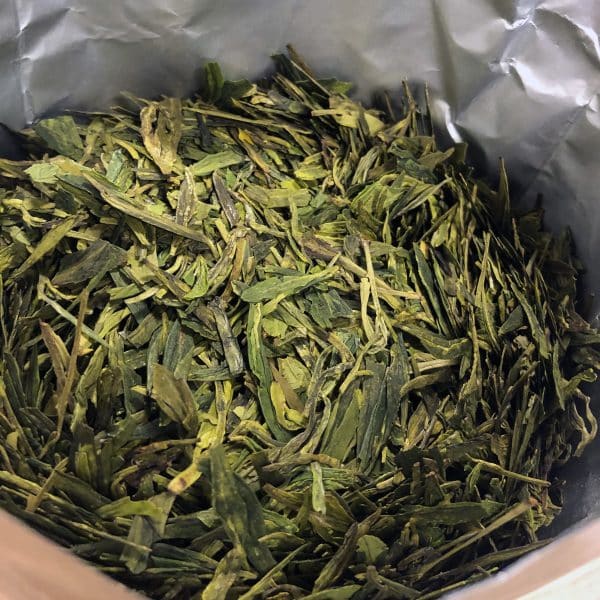Description
Long Jing, also known as Lung Ching, means “Dragonwell,” and you’ll often find this tea under that name. Not only is it a delicious Chinese green tea, but it also has historical and mythological significance, as well as a unique production method. Long Jing is so appreciated that it’s probably the most popular Chinese green tea. Its roasted character and, for a green tea, very mild and accessible flavor make this tea much loved, even in the West.
The flavor of Long Jing or Lung Ching has a very characteristic chestnut-like taste. But there’s more to it than that; floral tones, cookies, butter, and a sweet undertone also emerge when you brew Long Jing properly.
The Legend and History of Long Jing Tea
Long Jing or Lung Ching was one of the first pan-roasted teas from China. During the Ming Dynasty, people increasingly switched from powdered teas—like matchas—to full-leaf tea. During the Qing Dynasty, under the rule of Kangxi, this green tea first met imperial standards.
Originally, the tea comes from the Hangzhou region in China, from the village of Longjing. The village was named after a local well where groundwater seems to reflect various dragons. But not only the village of Longjing is known for this tea; the entire region is now called Dragonwell.
The most famous legend says that Emperor Qianlong visited the Dragonwell region and took some tea with him. Because his mother was ill, he had to return quickly to Beijing and put the tea leaves in his pocket. Once home, at his mother’s bedside, she could smell the aroma of the tea leaves and immediately asked the Emperor to serve the tea. According to legend, the Empress Dowager was so refreshed by the tea that the Emperor gave the tea bushes imperial status; The Imperial Tea Trees.
The Terroir and Production of Lung Ching
Lung Jing is tied to a region just like champagne is. The very highest quality of Long Jing comes from Xi Hu (West Lake), Hangzhou, China—the birthplace of this tea. But even within this region, there are differences to be seen. The Long Jing in this region, which already has an excellent terroir, is even more highly rated depending on the village where it is produced. The most prestigious terroir can be found in the village of Lion, followed by Dragon, Cloud, Tiger, and Plum (the English names the Chinese give to these villages).
The flush—or also: the harvest season—of Long Jing falls between February and April. During this period, two flushes occur. The ‘Pre-Qing-Ming’ (the first flush, which falls before the Qing Ming festival) and the ‘Qing-Yu’ (which means before the rain).
Long Jing can be recognized by its traditional flat leaf shape. This is obtained through a special method that the Chinese use for this tea. For green tea, one of the standard steps in the process is ‘killing the green.’ This is the step that ensures that the tea leaves will not oxidize and will remain green. During this step, the leaves are hand-pressed against a large wok. Long Jing gets its nutty flavor from this step. Pressing against the wok causes the leaves to lose their micro-hairs, resulting in a change in taste. After this step, the Lung Jing is baked until the leaves are almost crispy. Before, this was all manual labor, but the machines are now so perfected that they produce perfectly baked tea, just like manual labor. To get their specific, recognizable shape, the leaves are flattened. The next step is to pack the tea, usually in plastic bags, to minimize contact with air and get even more moisture out of the leaves. Afterward, they are flattened again, this time according to the Hui Guo technique. A technique that takes three years to master, according to the Chinese. The idea is to rub the tea leaves against the wok, all the leaves in the same direction to avoid broken leaves. The last hairs on the leaves are thereby removed. One more time, the tea is put in plastic bags and placed in a container with some lime for several weeks. Then only drying remains, and the packaging in bags to start the export.
How to Brew Long Jing Tea Best?
Long Jing is a green tea, which means it is highly sensitive to temperature. Usually, around 80 degrees is recommended for green tea—that’s an average that is given. For this specific Long Jing, we find that 85 degrees works best. In this way, you avoid bitters and get the most out of these high-quality tea leaves.
For the ratio of your tea leaves, you can choose whether to brew it the Gong Fu Cha way (we recommend using a gaiwan for brewing Long Jing), the Western way (with two pots or in a tea mug with a filter), or the Herbalistic way. For the gaiwan, use about 5 to 7 grams on 180 ml and let it steep briefly in multiple settings (start with 30 seconds, 45 seconds from the second setting). In the Western way, you either do 12 grams per liter (for 2 minutes) or 4 grams per cup/mug (for 2 minutes).
The Health Benefits of Long Jing Green Tea
Long Jing or Lung Ching can also contribute its bit for those who want to do something good for their bodies. Long Jing has many proven benefits. This green tea can help you lose weight. It does this by boosting metabolism and increasing fat burning. It’s no wonder that most fat-burning supplements will see green tea extract. This is a high-quality green tea, making it extra potent. The catechins and polyphenols are powerful components that, as antioxidants, can help prevent various aging diseases.
Ingredients
Green tea from China.











Reviews
There are no reviews yet.